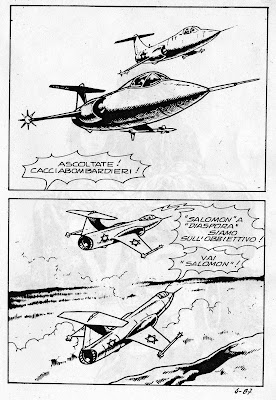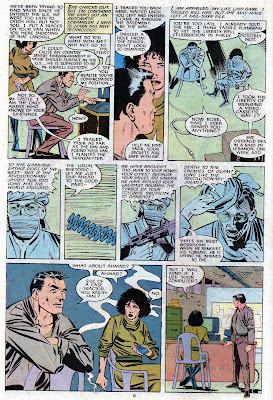During the '90s, a Christian anthology of comix stories (Aida-Zee #1, Nate Butler, 1990) included a story featuring Bukki, Warrior of Ancient Israel - a Samson-like man of strength who helped defend Israel from the Philistines circa 1050 B.C.E.

Buy Aida Zee #1
In one of the storylines in the syndicated Dick Tracy daily comic strip, Dick teams up with Israeli policeman Detective Stern.

In a 2-part Green Arrow story ("...And Not a Drop to Drink", Green Arrow #57-58, Feb.-Mar. 1992), the title character assists Mossad agents who have travelled to the U.S. on the trail of terrorists who have stolen radiocative material.

Buy Green Arrow #57 or #58
The Israeli military was depicted in both a serious and a humorous way during the 1990s.
In The New Two-Fisted Tales #1 (1993), legendary underground cartoonist Spain Rodriguez tells the story of the rescue of airline hostages in Entebbe, Uganda, based upon a script by Jessica Steinberg.


Buy The New Two-Fisted Tales #1
In "Fiddler on My Face" (Cud #5, Dec. 1993), author-illustrator Terry LaBan puts himself into a parodied version of the Broadway show Fiddler on the Roof, itself based on the stories of Sholom Aleichem. In this tale, the villagers of the shtetl aren't at the mercy of Coassacks during a pogrom, but instead are saved by a heavily-armed modern Israeli paratrooper. Though unexplained, it's probable that he arrived through a rift in the space-time continuum.

Faced with the impending threat of an onslaught of sword-wieleding soldiers on horseback, Yossi Ben Moshe of the Elite Israeli Commandos guns them all down, leaving a mess of corpses on the ground.

Threatened no longer, Terry decides to immigrate to the Promised Land - not Israel, but the United States! However, he soon discovers that it isn't quite as promising as he was led to believe.

Buy Cud #5
Four Israeli superhero characters were introduced during the '90s. As with the ones of previous decades, the stories they were used for tended to be formulaic and uninteresting.
Among these superheroes were :
Golani (Teenage Mutant Ninja Turtles Adventures #53, Feb. 1994)

Masada, who hears voices in her head - the voices of those gave their lives in the name of Judaism, from whom she dervies her super-powers (Youngblood Strikefile #6, Aug. 1994)

Buy Youngblood : Strikefile #6
Sentinel, a member of an international team of superheroes called U.N.Force (UNForce #5, 1993)

Buy UNForce #5
The Hayoth - a team of Israeli superheroes, composed of Golem, Dybbuk, Judith and Ramban (The Spectre #15, Feb. 1994)

Buy Spectre #15
In The New Warriors #58 (Apr. 1995), Sabra is assigned bodyguard duty for Prime Minister Yitzhak Rabin during a trip to the U.S. to negotiate for peace with Syria's Hafez Assad. This time, Sabra's seemingly irrational behavior (attempting to kill the leaders of both countries) is caused by her being brainwashed during an operation.

This may be the only depiction of Yitzhak Rabin in an American comic book.

Buy New Warriors #58
Although, there were no Jewish characters in any of the Star Trek films or television shows, one of the Star Trek comic series - Starfleet Academy - had a half-Jewish, half-Muslim character named Kamilah Goldstein. However, she was killed in the 5th issue. The first pages of 6th issue (May 1997), show her funeral in Jerusalem.

Buy Stat Trek : Starfleet Academy #6
The miniseries The Nostradamus Chronicles (1997) attempted to show, in pictures & words, how many of Nostradamus' predictions have seemed to come true. Among the verses chosen is Quatrain III verse 97, which seems to predict Israeli statehood.

Buy Nostradamus Chronicles : 1917-1945
In Japan, the "godfather of manga" (Osamu Tezuka) serialized one of his lengthy (over 1000 pages) masterpieces Adolf ni Tsugu. For its English translation, the story was divided into 5 books. The major themes dealt with in the story are militarism, racism, and nationalism. Specifically, it examines how these ideologies can become dangerous, particularly when they are combined, as was the case with both Imperial Japan and Nazi Germany (the settings for the first 4 books). It might have been easy for Tezuka to conclude that the modern equivalent of those regimes is the state of Israel.

However, Tezuka seems to have chosen not to go that route. Instead he aimed his critical pen at Arab nationalism, comparing the anti-Semitism of its extremist proponents with that of their Nazi predecessors.

Buy Adolf : 1945 and All that Remains (book 5)
Desert Storm Journal combined docu-drama with historical facts. In its 2nd issue (Dec. 1991), the main character - an American journalist - finds himself in Israel where his daughter is working as a volunteer during the days of Iraqui bombardment.

In this simplistic, pre-Palestine 2-page piece, comics journalist Joe Sacco depicts the actions of Palestinians cheering the bombing of Israeli targets by Iraqui scuds, while transcribing an excerpt from Menachem Begin's book The Revolt. By doing so, Sacco tries to demonstrate that the Palestinians of the present are reacting in the same ways that the Jews of pre-1948 Israel did prior to statehood. This piece was reprinted in War Junkie : Illustrated Tales of Combat, Depression & Rock 'n Roll (Fantagraphics, 1995, p. 120-121).

Buy War Junkie : Illustrated Tales of Combat, Depression & Rock 'n Roll
Although Sacco's Palestine miniseries sold terribly in its comic book form (Sacco claims that it was Fantagraphics' worst-selling title at the time), his publisher decided to publish the entire 9-issue run and - later - republsuhed the content in 2 trade paperbacks subtitled In the Gaza Strip and A Nation Occupied. These books fared considerably better, both critically and financially. A collected edition was later published and last year a hardcover "special" edition with added content (e.g. original artwork) was also produced. The story "Hebron" from the issue of Palestine was reprinted in The new Smithsonian book of comic-book stories : from Crumb to Clowes (edited by Bob Callahan, Smithsonian Books, 2004).
Among the recognition Sacco has won for his work on Palestine are the VPRO Grand Prix of Harlem Award, the Firecracker Award and the American Book Award.
According to a Worldcat search performed on June 18th, 2008, at least 837 OCLC libraries (or library systems) own at least 1 copy of Palestine (the collected edition).
In this text-heavy page from Palestine #3, Sacco compares illegal Palestinaian homebuilding to illegal Israeli homebuilding.

Buy Palestine : The Special Edition
Harvey Pekar and his wife Joyce Brabner recounted the period during which Harvey battled cancer in the graphic biography Our Cancer Year (Four Walls Eight Windows, 1994). During that year, Joyce travelled to the Middle East to meet with idealistic youth who were trying to work towards peace. She ended up being in Israel during the first Gulf War.

Buy Our Cancer Year
Author-illustrator Peter Kuper (formerly of Cleveland) spent a year in Israel when he was a child. In his short piece "Promised Land" (Bleeding Heart #2, March 1992), he reflects on how his views and feelings towards the state have evolved.

Buy Bleeding Heart #2



































































